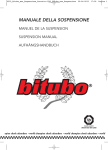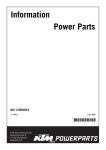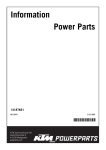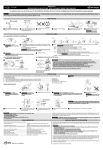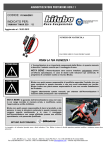Download gehts zum
Transcript
Owners manual_ 5_gesamt.qxd 03.05.2005 21:39 Uhr Seite 1 OWNERS MANUAL WP Suspension shock absorbers ROAD & TRACK 01 - 2005 - Art. no.: 5300.0082. Your WP Suspension dealer www.wpsuspension.com www.wpsuspension.com Owners manual_ 5_gesamt.qxd 03.05.2005 21:39 Uhr Seite 3 GB GB All of WP Suspension advanced suspension products are adapted to the brand and model. This means that length, travel spring actions and damping characteristics, are tested individually just for the motorcycle that you have decided to fit with WP Suspension. INTRODUCTION Safety Signals Important information concerning safety is distinguished in this manual by the following notations. The safety alert means: Caution ! Your safety is involved. WARNING ! Failure to follow warning instruction could result in severe or fatal injury to anyone working with, inspecting or using the suspension,or to bystanders. CAUTION ! Caution indicates that special precautions must be taken to avoid damage to the suspension. NOTE ! This indicates information that is of importance with regard to procedures. BEFORE INSTALLATION WARNING ! Installing a shockabsorber that is not approved by the vehicle manufacturer, may affect the stability of your vehicle. WP Suspension B.V. cannot be held responsible for any perso- nal injury or damage whatsoever that may occur after fitting the shock absorber. Contact a WP Suspension dealer or other qualified person for advice. WP Suspension B.V. can not be held responsible for any form of damage to shock absorber or vehicle, or injury to qualified person for advice. WP Suspension B.V. can not be held responsible for any form of damage to shock absorber or vehicle, or injury to persons, if the instructions for fitting and maintenance are not followed exactly. Similarly, the warranty will become null and void if the instructions are not adhered to. WARNING ! Pleasy study and make certain that you fully understand all the mounting instructions and the owner’s manual before handling this shock absorber. If you have any questions regarding proper installation procedures, contact a WP Suspension dealer or other qualified person. TUNING THE SUSPENSION All motorcycles are designed with a suspension geometry that includes height and fork angle. The changing of components can affect this and it is therefore essential that both the rear and the front ends match each other. Changing to WP Suspension gives optimum performance only when both the front and the rear suspensions interact properly. It is of the greatest importance that the front and rear loaded height are within the specified values. See section: Setting the spring preload. SETTINGS Basic setting Always ensure that the basic setting made by WP Suspension is correct (see mounting instruction). It is adapted to the make and model and for a rider of average weight. Everything must harmonize There are WP Suspension front fork springs, they are specifically adapted to the shock absorber recommended to your motor-cycle. Incorrect spring action can give a fork angle that is too steep or too flat. This in turn will give a tendency for oversteering or understeering, wich could seriously affect the handling of the motorcycle. SETTING THE SPRING PRELOAD 1. Measuring: Preload on the spring/springs is very important, because it affects the height of the motorcycle and the fork angle. Consequently, handling characteristics can be changed, even negatively. Proceed as follows (it will be much easier if done by two persons): • Place the motorcycle on a smooth surface. • Lift up the rear to a fully extended position. • Measure the distance, from the lower edge of the rear mudguard or from a point marked by a piece of tape, immediately above the rear wheel axle, to the wheel axle. (Fig. 1) • Make a similar measurement on the front axle, eg, from the bottom of the upper triple clamp to the front wheel axle. The fork must also be fully extended. • Allow the motorcycle (withoutrider) to apply load on the springs and repeat the measuring procedure. (Fig. 2) • Then take the same measu rements with the rider and equipment on the motorcycle. It is important that the rider has a correct riding posture, so that the weight is balanced on the front and rear wheel in the same way as when riding. (Fig. 3) The measurements may not differ from the following sizes. Without rider: (A-B) Rear: 5 –10 mm Front: 25 – 30 mm With rider: (A-C) Rear: 30 – 40 mm Front: 35 – 50 mm front fork springs are available for almost all motorcycles. These in combination with WP Suspension shock absorbers, contribute to superior road holding qualities. Fig. 3 2. Adjusting: Adjust the preload with the lock retainer on the shock absorber or by hydraulic preloading (Fig. 4). Use an Allen key to loosen the Allen bolt in the lock retainer and adjust the retainer to the position using the special tool (Fig. 5, 6 + 7). Lock the Allen bolt again after adjusting. For hydraulic preloading, increase by turning clockwise and reduce by turning anticlockwise. (Fig. 4) NOTE ! Do not over tighten the Allen bolt in the lock retainer. On a shock absorber that has hydraulic setting the basic position can be adjusted. Such changes should be attended to by an WP Suspension authorized service workshop. Fig. 1 Fig. 4 Fig. 2 FRONT FORK SPRINGS To optimize the road holding qualities of a motorcycle the front fork must match the rear suspension. WP Suspension NOTE ! Remember to change the fluid in the front fork at least once every year. We recommend using WP Suspension front fork oil. SETTING THE DAMPING The adjusting possibilities of the WP Suspension shock absorbers facilitate very fine settings. You can optimize adjustments to suit your own weight and equipment, your individuel way of riding and the condition of the road. To be able to improve the road holding qualities it is of the outmost importance that you fully understand the functioning of the shock absorber. Then you can learn by trial and error how they affect the motorcycle. Depending on the model, there are adjustments for rebound damping, compression highspeed damping, compression low-speed damping and adjustment for the length of the shock absorber. The damping can be set with the special tool that is included with the shock absorber. By turning clockwise they increase the damping and anticlockwise they reduce it. The adjustments have definite positions with a noticeable “click ”, so it is easy to count to the correct setting. NOTE ! Always count the “clicks” back from fully closed ! WP Suspension B.V. All rights reserved. Any printing or unauthorized use without the written permission of WP Suspension B.V. is prohibited. WP Suspension B.V. All rights reserved. Any printing or unauthorized use without the written permission of WP Suspension B.V. is prohibited. www.wpsuspension.com www.wpsuspension.com Owners manual_ 5_gesamt.qxd 03.05.2005 21:39 Uhr Seite 5 GB D WARNING ! Rebound damping affects the characteristics the most, do not ride with the rebound damping fully closed ! The setting adjustment screw of the rebound damping is at the bottom on the piston rod. (Fig. 5, 6 + 7). The compression high-speed and the compression lowspeed damping can be adjusted at the reservoir (Fig. 5 + 6). NOTE ! When making new adjustments it is easiest to go back to fully closed, and then count forward to the new setting. The adjustment screws should not be screwed in too hard. SETTING THE SHOCK ABSORBER LENGTH Sensitivity of the steering can be adjusted by altering the length of the shock absorber, without affecting other characteristics. The length is adjusted using the nut (size 22) down and the threaded clevis at the Fig. 5 end of the piston rod. (Fig. 8) The shock absorber can be adjusted up to a length that may never be more than to where the groove cut in the thread becomes just visible. (Fig. 8 – E) WARNING ! If the shock absorber has an adjustable end eye/bracket, this must not be threaded out more than that the groove is fully visible beneath the lock nut. Make sure that the lock nut is tightened after adjustment. Alle Federungs-Produkte von WP Suspension sind für eine bestimmte Marke und Modell ausgelegt. Deshalb sind Länge, Federaktion und Dämpfungs-Charakteristiken individuell auf Ihr MotorradModell zugeschnitten. WARNING ! Never alter the gas pressure. Special purpose charging equipment and acces to nitrogen is required. The gas pressure should normally never be altered. Sicherheitshinweise Wichtige Informationen über Sicherheit sind in diesem Handbuch wie folgt gekennzeichnet: NOTE ! Regular maintenance and inspection contribute to the prevention of functional disturbances. SETTING YOUR MOTORCYCLE NOTE ! Always begin with the basic setting recommended by WP Suspension. Always make notes, adjust in small steps and make only one adjustment at a time. Adjustments should be made with two clicks at a time. By utilizing the adjustment possibilities you can test by trial and error, and learn Fig. 6 how they affect your motorcycle. Always begin by test riding the motorcycle with all adjustments at their delivery setting. Choose a short run of varying character, ie, long and sharp bends, hard and soft bumps. Keep the same run and adjust only one setting at a time. By choosing the quality and the customising options of WP Suspension products, you are choosing for optimum safety and comfort. Fig. 7 EINLEITUNG WARNUNG ! Versäumen Sie nie dieser Warnung Folge zu leisten, dieses kann zu ernsthaften oder tödlichen Verletzungen führen. Das gilt für Fahrer, als auch für Personen, die an der Federung arbeiten oder für Dritte. VORSICHT ! Signalisiert, dass spezielle Vorsichtsmaßnahmen getroffen werden müssen, um das Federbein nicht zu beschädigen. NOTIZ ! Zeigt Informationen, die wichtig für die Handhabung sind. Fig. 8 VOR DEM EINBAU B C B C E D D D E A A A A = Rebound adjustment B = Low-speed compression adjustment C = High-speed compression adjustment D =Allen bolt spring lock retainer WARNUNG ! Der Einbauen eines, nicht durch den Hersteller freigegebenen Federbeins, kann die Stabilität Ihres Fahrzeuges beeinflussen. Die Firma WP Suspension haftet nicht für Schäden oder Verletzungen, die durch den Einbau des Federbeins verursacht wurden. Lassen Sie Ihre WP Produkte von einer Fachwerkstatt einbauen oder fragen Sie eine dafür qualifizierte Person um Rat. WP Suspension ist nicht verantwortlich für Schäden an Federbeinen, Fahrzeugen oder Personen, die durch nicht fachgerechte Montage/Wartung entstanden sind. Mit einer nicht fachgerechten Wartung oder Montage erlischt der GarantieAnspruch. WARNUNG ! Bevor Sie Veränderungen an Ihrem Federbein durchführen, bitte wir Sie, das Handbuch ausführlich zu lesen. Vergewissern Sie sich, dass Sie alle Punkte im Handbuch richtig verstanden haben. Falls Fragen auftreten, stellen Sie diese bitte einem WP Suspension Händler. EINSTELLUNGEN Grundeinstellung Versichern Sie sich, dass die Grundeinstellung von WP Suspension korrekt ist (siehe Montageinstruktionen). Diese ist eingestellt auf die Marke, das Modell und auf einen Fahrer mit Durchschnittsgewicht. Alles muss Harmonieren Es gibt WP Gabelfedern, die spezifisch auf ein FederbeinModell angepasst sind und für ein Motorrad-Modell empfohlen werden. Falsche Federhärte kann zu einem zu steilen oder zu flachen Gabelwinkel führen. Dieses führt wiederum zu Unter- oder Übersteuern, was starke Auswirkungen auf das Handling des Motorrades haben kann. FEDERUNG EINSTELLEN Die Konstruktion eines Motorrades beruht auf einer geometrischen Federung, einschließlich Höhe und Gabelwinkel. Der Austausch von Komponenten kann diese Geometrie beeinflussen, es ist daher äußerst wichtig, dass Front und Heck des Motorrades aufeinander abgestimmt sind. Der Einbau eines WP Suspension Produktes gibt nur dann ein optimales Resultat, wenn die Front- und Heck-Federung richtig miteinander arbeitet. Es ist äußerst wichtig, dass die vorn und hinten gemessenen Höhen innerhalb der spezifizierten Toleranzgrenzen liegen. Siehe: Federvorspannung einstellen. FEDERVORSPANNUNG EINSTELLEN Die Vorspannung der Feder/ Federn ist sehr wichtig, weil es die Höhe des Motorrades und den Gabelwinkel beeinflusst. Der Handlingcharakter kann zum Positiven als auch zum Negativen verändert werden Einstellungen sind einfacher mit zwei Personen durchzuführen. • Stellen Sie das Motorrad auf eine ebene Oberfläche. • Heben Sie die Hinterseite hoch, bis sie ganz ausgefedert ist. • Messen Sie die Distanz, z.B.: von der Unterseite des Kotflügels, oder von einem markierten Punkt, über die hintere Radachse, bis zu der Radachse (Fig. 1). WP Suspension B.V. All rights reserved. Any printing or unauthorized use without the written permission of WP Suspension B.V. is prohibited. Alle Rechte sind WP Suspension vorbehalten. Kopieren oder Drucken ohne schriftliche Zustimmung von WP Suspension ist verboten. www.wpsuspension.com www.wpsuspension.com Owners manual_ 5_gesamt.qxd 03.05.2005 21:39 Uhr Seite 7 D D • Messen Sie die Vorderachse genauso, z.B.: von der Unterseite der oberen Achsaufnahme, bis zur vorderen Radachse. Die Gabel muss ganz ausgefedert sein. • Lassen Sie das Motorrad (ohne Fahrer) vom Ständer und wiederholen Sie die Messung (Fig. 2). • Wiederholen Sie die Messung ein weiteres Mal mit Fahrer und Gepäck auf dem Motorrad. Wichtig ist, dass der Fahrer in der richtigen Fahrposition sitzt, so dass das Gewicht aufgeteilt ist auf das Vorder- und Hinterrad (reale Fahrsituation, Fig. 3). Die Abmessungen sollten nicht von den folgenden Daten abweichen: Ohne Fahrer: (A-B) hinten: 5 –10 mm vorn: 25 – 30 mm Mit Fahrer: (A-C) hinten: 30 – 40 mm vorn: 35 – 50 mm zeichneten Fahrverhalten bei. Fig. 3 NOTIZ ! Denken Sie daran, dass Gabelöl mindestens einmal im Jahr zu wechseln. Wir empfehlen WP Suspension-Gabelöl. 2. Justieren Justieren Sie die Vorspannung mit dem Federteller auf dem Federbein oder mit der hydraulischen Vorspannung (Fig. 4) Nutzen Sie das Spezialwerkzeug, um die InnensechskantSchraube in dem Federteller zu lösen (Fig. 5, 6 + 7) und den Federteller in die gewünschte Position zu drehen. NOTIZ ! Achten Sie darauf, die Schraube in der Federvorspannung nicht zu stark anzuziehen. An einem Federbein mit hydraulischer Federvorspannung kann die Grundeinstellung geändert werden. Diese Veränderung sollte durch eine Fachwerkstatt durchgeführt werden. Fig. 4 Fig. 1 GABELFEDERN Fig. 2 Um das Handling auf der Straße zu optimieren, müssen Gabel und Federbeine aufeinander abgestimmt sein. WP Gabelfedern sind für die meisten Motorrad-Modelle erhältlich. Diese, zusammen mit WP Suspension Federbeinen tragen zu einem ausge- EINSTELLEN DES FEDERBEINS Die Federbeine von WP Suspension können sehr fein eingestellt werden. Sie können optimal auf Ihr eigenes Gewicht und das Gewicht des Gepäcks/ Sozius eingestellt werden. Zudem können Ihr Fahrstil und die Straßenverhältnisse in der Einstellung berücksichtigt werden. Um die Straßenhaftung zu verbessern, ist es äußerst wichtig, die Funktionen von dem Federbein genau zu kennen. Sie können durch Ausprobieren lernen, welche Auswirkungen die einzelnen Funktionen auf das Motorrad haben. Abhängig von dem Modell, können Sie folgendes verstellen. Z.B: Zugstufendämpfung, High Speed/ Low Speed Druckstufendämpfung und Federbein-Länge. Die Dämpfung kann eingestellt werden mit Hilfe eines mitgelieferten Werkzeuges. Das Verstellen der Verstellschraube im Uhrzeigersinn erhöht die Dämpfung, während sie beim Drehen gegen den Uhrzeigersinn vermindert wird. Die Einstellungen haben klar definierte Positionen, die mit einem hörbaren “Klick” einrasten. Dadurch wird das Mitzählen bis zur gewünschten Einstellung erleichtert. NOTIZ ! Zählen Sie die “Klicks” von der Ausgangsposition (Schraube ganz reingedreht, Fig. 4). Alle Rechte sind WP Suspension vorbehalten. Kopieren oder Drucken ohne schriftliche Zustimmung von WP Suspension ist verboten. www.wpsuspension.com WARNUNG ! Die Zugstufendämpfung hat große Auswirkungen auf den Charakter des Motorrades. Fahren Sie nie mit einer komplett geschlossenen Zugstufendämpfung ! Die Einstellschraube von der Rebound-Dämpfung ist unten an der Kolbenstange zu finden (Fig. 5, 6 + 7). Die Druckstufe High/Low Speed-Dämpfung kann am Ausgleichsbehälter eingestellt werden (Fig. 5 + 6). NOTIZ ! Bei Neueinstellungen ist es einfacher, ganz zu zu schrauben und dann die “Klicks” nach bis zur gewünschten Neueinstellung zu zählen. Schrauben Sie die Einstellschraube nie zu fest. FEDERBEINLÄNGE EINSTELLEN Die Empfindlichkeit beim Lenken kann durch die Federbeinlänge variiert werden. Die anderen Fahrwerksmerkmale Fig. 5 B werden damit nicht beeinflusst. Die Länge kann eingestellt werden mit der Einstellmutter (Größe 22) und dem Halter am Ende der Kolbenstange (Fig.8). Die Federbeinlänge kann soweit verändert werden, bis die Rille im Gewinde immer noch sichtbar ist (Fig. 8 – E). WARNUNG ! Hat das Federbein eine Längenverstellung, schrauben Sie diese nie so weit raus, dass die Rille unter der Mutter nicht mehr vollständig sichtbar ist. Versichern Sie sich, dass die Mutter nach der Verstellung festgemacht ist. MOTORRAD EINSTELLEN NOTIZ ! Fangen Sie immer mit der WP Suspension Grundeinstellung an. Machen Sie zu jedem Schritt Notizen. Verstellen Sie in kleinen Stufen und führen Sie die Einstellungen eine nach Fig. 6 C B der anderen durch. Verstellen Sie mittels zwei “Klicks”. Beim Testen der Einstellungen können Sie ausprobieren, welche Auswirkungen diese auf das Motorrad haben. Fangen Sie immer mit einer Probefahrt an, bei der alle Einstellungen in der ausgelieferten Grundeinstellung sind. Wählen Sie eine kurze Strecke mit verschiedenen Merkmalen, z.B. lange und scharfe Kurven, große und kleine Hügel. Wiederholen Sie dann die gleiche Strecke und ändern Sie jedes Mal nur eine Einstellung pro Fahrt. WARNUNG ! Ändern Sie nie den Gasdruck. Füllgeräte und Stickstoff sind dazu nötig. NOTIZ ! Regelmäßige Wartungen und Inspektionen verhindern Funktionsstörungen. Wählen Sie die Qualitätsprodukte von WP Suspension und damit Sicherheit und Komfort. Fig. 7 Fig. 8 C E D D D E A A A A = Zugstufe einstellen B = Druckstufe Low-Speed einstellen C = Druckstufe High-Speed einstellen D = Innensechskant-Schraube Federteller Alle Rechte sind WP Suspension vorbehalten. Kopieren oder Drucken ohne schriftliche Zustimmung von WP Suspension ist verboten. www.wpsuspension.com






